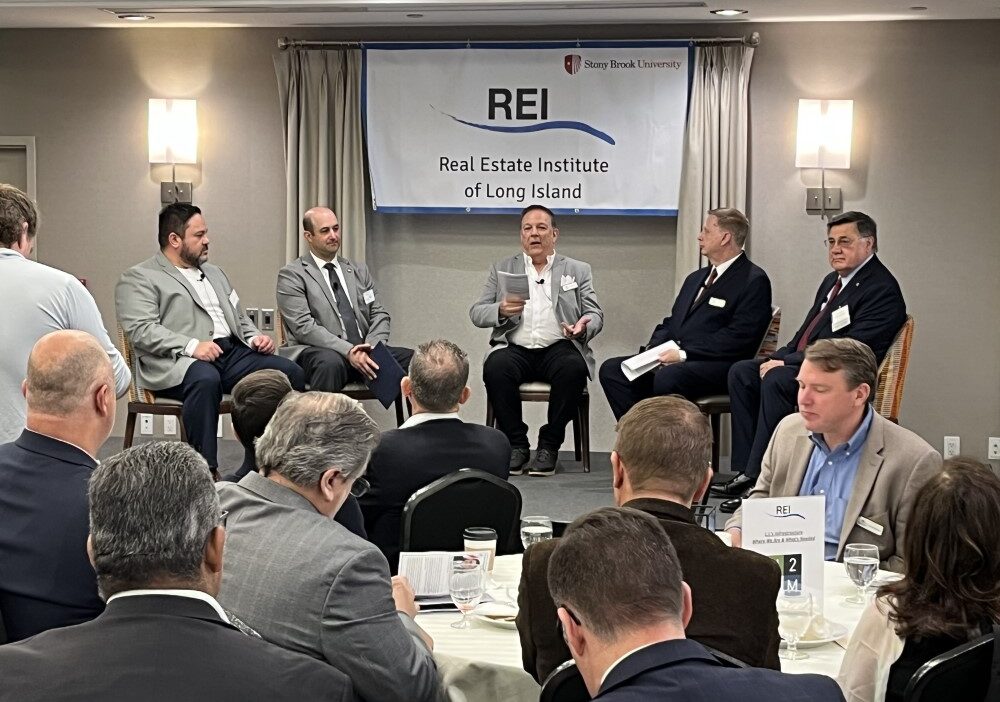Suffolk County Executive Ed Romaine joined a panel of real estate industry executives and a state official Thursday to explore infrastructure challenges on Long Island.
The event, titled “LI’s Infrastructure: Where We Are & What’s Needed,” was hosted by the Real Estate Institute of Long Island at the Hilton Garden Inn at Stony Brook University.
Moderated by David Pennetta, executive managing director of Cushman & Wakefield of Long Island, the panel included Romaine; Rob Calarco, New York State assistant secretary for Intergovernmental Affairs Long Island; Sammy Chu, a member of the Metropolitan Transportation Authority board and CEO of Edgewise Energy; and Peter Elkowitz, CEO of the Long Island Housing Partnership.
In a keynote address before the panel discussion, Romaine stressed the importance of upgrading Suffolk’s infrastructure and how inadequate infrastructure is a major obstacle to the county’s economic growth.


“If you want to improve the economy of a country, a state or a county, there’s no better way to do it than to improve its infrastructure,” Romaine told the gathering of nearly 200.
The county executive said that Suffolk is being shortchanged by the state in funding for roads and bus transportation and is lacking a modernized rail system.
“We have so many people in cars because we don’t have a good public transportation system,” Romaine said. “Electrification is something that’s key to our future. Imagine what it would do for the value of real estate if there were electric trains from Babylon to Montauk, from Huntington to Port Jefferson and from Ronkonkoma to Greenport.”
Romaine also addressed the county’s lack of sewers, acknowledging that 70 percent of Suffolk relies on cesspools.
“I’m committed to expanding our sewer system,” he said. “We plan to spend about $1 billion on sewers in the next three years, and that’s a drop in the bucket.”
Pennetta opened the panel discussion by asking “How do we get this moving forward?”
Chu, who’s company specializes in energy storage systems, addressed the need for upgrading Long Island’s electric grid.
“We have to transition the grid. We need new assets…moving away from commodity-based energy is important,” he said. “Energy storage is what we’re zeroed in on to make a more resilient grid.”
Calarco added that a new state fire code, which includes updates and additions to improve coordination, safety and emergency preparedness in the planning of energy storage projects, is likely to be enacted in July.
Romaine said he is a big supporter of solar and wind power, but that the Long Island Power Authority (LIPA) needs to upgrade its substations to accommodate those energy sources and there needs to be more battery storage to make it all work.
Elkowitz said that Long Island’s biggest challenge, its lack of available and attainable housing, is dependent on infrastructure improvements and sewer expansion.
“Everyone needs a place to live…It’s all based on availability of housing,” he said.
Elkowitz said that the lack of sewers drives up the cost of new housing and illustrated the point by talking about a LIHP affordable housing development in North Bellport. Each of the single-family homes will also have a one-bedroom accessory apartment and will be sold to first-time home buyers through LIHP’s Community Land Trust program.
“There was no infrastructure, it was just vacant land,” he said. “If we didn’t put in a sewage treatment plant, we’d only be able to build 12 to 14 units. Now we’re going to have 32.”
The cost of adding the infrastructure, Elkowitz said, throws the economics out of whack. He said someone making 80 percent of the area median income of about $131,000 can afford a house priced at no more than $460,000, but it costs close to $1 million to build it and the infrastructure required.
“That means some $517,000 in subsidies is needed,” Elkowitz said. “If you look at those numbers they just don’t add up.”



